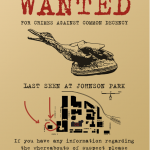Fall 2024 – Emerging Media
Experimental Emerging Media with Professor James J Brown
One of the classes that I took in the Fall 2024 semester of my masters program was Experimental Emerging Media with Professor Jim Brown. The purpose of this class was to explore creativity and interactions with different types of media – the focus was on emerging media and how it can impact the actual research or creative project. I got stuck on the idea of media archaeology within this class, and coupled with my research into payphones for my capstone in the Digital Studies major of my BA, it led to an interesting project proposal for this class.
My presentation for the project was designed to look similar to a phone book – this is something that most people today are not familiar with, but was a staple of life in a bygone era. It started out with multiple muted colors that would’ve been very trendy in the 1970s, but I ended up embracing a suggestion from Professor Brown and switching to a yellow palette for the theme of the presentation. He suggested this would make it more obvious that the presentation was supposed to look like a phone book. (e.g. ‘yellow pages’)

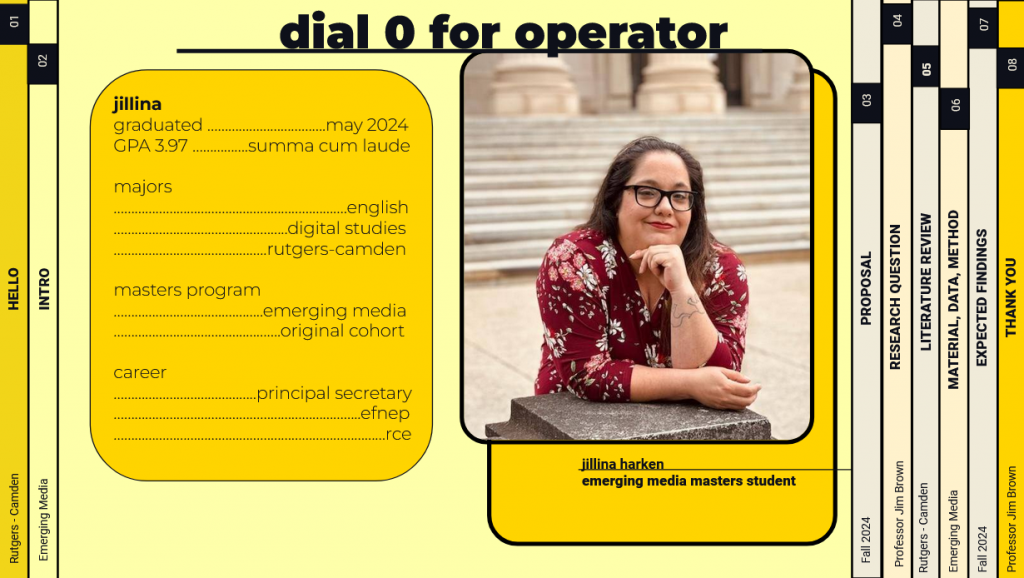
I used the tabs along the edges of the slides to be the ‘headers’ for the different topics I was going to speak on, while also allowing the audience to be able to keep track of where in the presentation we were. I’ve always appreciated the lectures where professors did something similar to this, so I incorporated it into my presentation here and I feel like it worked out pretty well. Another style choice for this presentation was using rounded-corner rectangles to contain the information I was presenting. For those who are familiar with a phone book, this was meant to emulate the ads or higher-priced ‘feature’ spots within a phone book.
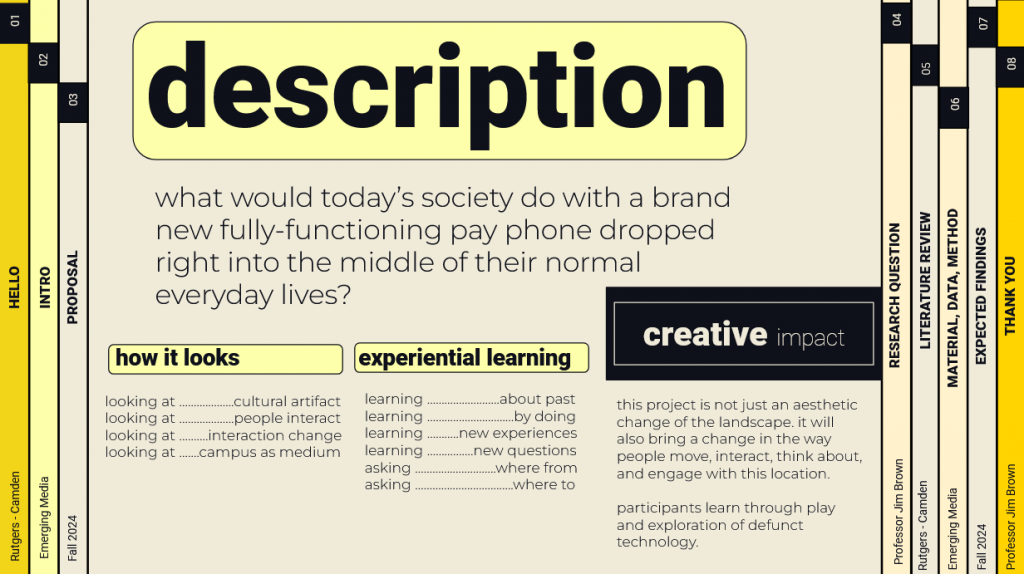
In several instances, I also used the dotted line to break things up, this was a feature in most phone books between the name and number of the person/business being listed. This was helpful when scanning a page to find a number because it ensured that the user was able to clearly tell which number went with which listing. In monochromatic print phone books, ads and features were often printed like the “creative impact” section’s heading – full black with ‘cut out’ letters where there was no ink. This bold choice was something that I recall as particularly fun when playing with a glob of silly putty – those bold black inks usually picked up really well.
This slide is where I go into the idea of my project: to install a working payphone in the campus quad here at Rutgers-Camden.
My project started out very aggressive in nature, demanding a call to action and imposing my own perception of solutions on the community the booth was installed in. One of the interesting aspects of the original idea was that the phone booth was to be used as a community art installation, but the underlying reasoning and theories wouldn’t come together in a coherent manner, and I feel like that was because I was forcing the idea and really scattered in my thinking about the project as a whole.
Moving away from the art, social justice, and desire to push buttons I ended up with media archaeology and medium design as my focus points to drive home this project and keep it from being scatter brained. So, instead of forcing the role of community art, I decided I’d like to study the interactions of modern society with a new payphone dropped into the middle of their everyday lives. Because this campus has a diverse population it would be interesting to see how each demographic interacted with the payphone. In consideration of the medium design aspect we look to the work of Keller Easterling, and I believe she would suggest that a project like this would turn the entire quad into the medium.
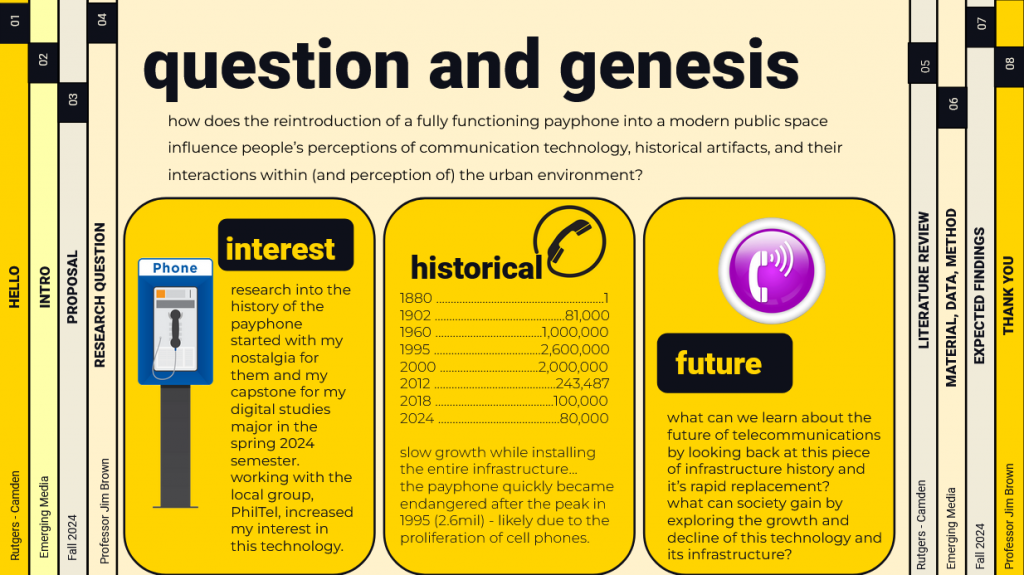
When I made an essay film in the Spring 2024 semester on the disappearance of payphones and the digital divide it sparked a pretty deep level of interest in the payphone, its history, the rise and fall of the technology, and a lot of questions about what is happening to that infrastructure in today’s world. But above this, I am curious to know if there’s something we can learn from interacting authentically with a payphone. Would interaction with this antiquated technology bring more interest, concern, and curiosity to the telecommunication industry?
I constantly think back to stories of disaster where payphones became lifelines to people. In situations like 9-11 and major hurricanes (Katrina was specifically mentioned in my literature reviews.), payphones are often the only method of communication in disaster areas. The modern wireless network gets overloaded, or the highly sensitive hardware gets messed up, runs out of charge, or is easily broken. One of the major advantages of a payphone in this situation is that the phone is run on power from the phone company – the devices, including any corded home phone line, were powered through the same RJ45 wire that brought the voice service. Looking at these vital pieces of the telecommunication infrastructure of the past could inspire further innovation in telecommunications as we question how we could bring the pros of those past technologies forward into the modern world and carry it further into the future.
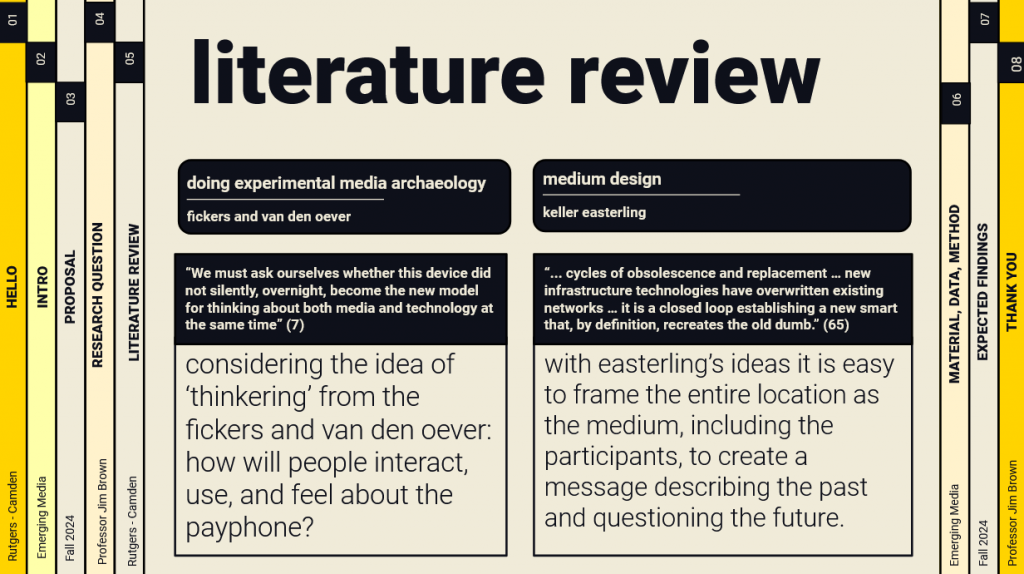
fickers and van den oever – thinkering
This book left me with a lot of thoughts and ideas, but I think the one that hit me the hardest and has really been rattling away in my brain since I read it is “thinkering.” It even amuses me to see the angry red squiggly line beneath that word as grammar check tries to tell me I’ve spelled something wrong. But no, “thinkering” comes from Fickers and van den Oever’s book Doing Experimental Media Archaeology. It’s a new word that brings together ‘thinking’ and ‘tinkering’ to describe the process of media archaeology. Fickers and van den Oever describe a way of interacting with artifacts from the past that would make a museum director’s head spin. They want us to take these items from the past, remove them from their glass cases, and tinker with them. Explore their affordances, discover how they work, and uncover the ingenuity that went into their initial creation.
keller easterling – medium
One of the most critical aspects of this project is how the phone booth alone is not the medium of this project. The installation of the phone will change the entire location as well, turning the location and people into the medium as well as the physical phone. As people walk through the quad they will see the phone and become curious. This changes how they talk about the space – they will say to friends or acquaintances later they saw a payphone in the quad; perhaps that person will as if they used it, and together they will wonder if it works and consider going back to the quad to find out. This gives the quad another use, once again changing the location. As people talk about the phone and try it out the location will be further changed because traffic patterns will change, the amount of time people are spending in the quad will change, and likely the way all this traffic interacts with one another will be different as well.
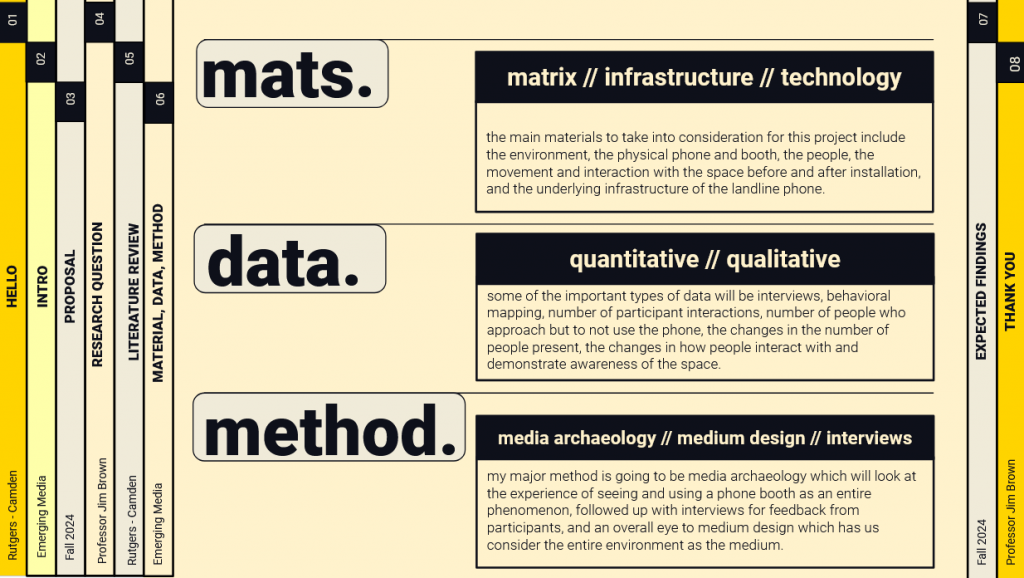
This page really covers the different types of materials needed, data types to collect, and speaks more about the methods used here. One additional method that could be used after this project is put into place could be something like phenomenology as we consider the interactions of each person with the phenomena of the payphone.
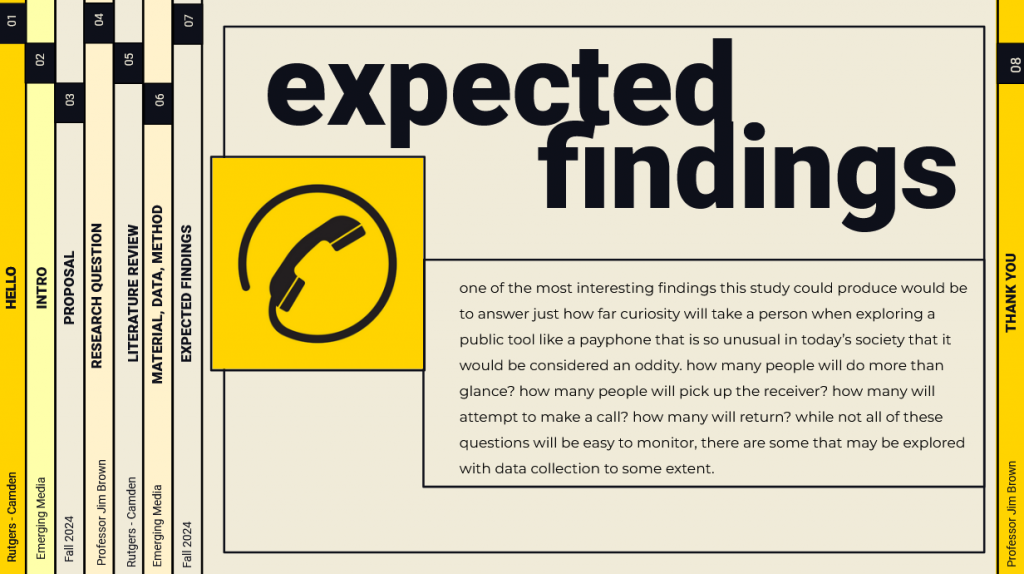
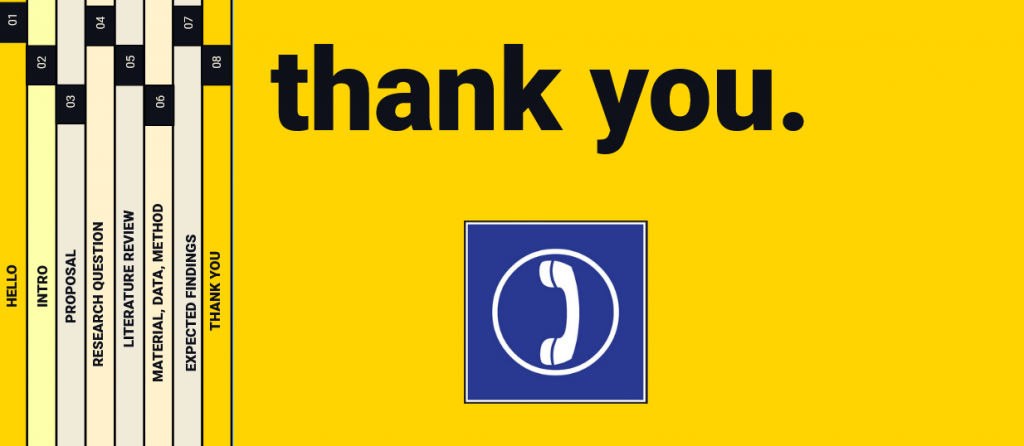
The end of the presentation ties up many of the things I’ve already written here, and ends with an old phone icon which used to be far more visible in society than it is today. I think it’s a little funny-weird that we now use the rectangle of a smart phone to depict a phone now, but the save icon is still the 3.5″ floppy disk. This is one example of how some obsolete technologies still have a great deal of visibility in the world today and it brings up interesting questions about why that is. I’ve often wondered why the payphone and landline phone – which were arguably around far longer than the floppy disk (from the days of the 8″ disks, the 5.25″ disks, and the 3.5″ disks!) – disappeared so quickly while we still use the disk as an icon on computers decades after we swapped to the USB and cloud iterations of data storage.
This project was fun to conceptualize, and there may be a revival of this idea in the future to see if it could be brought into reality.

